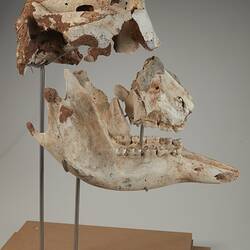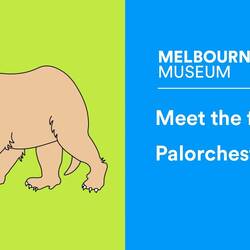Palorchestes azael was a giant marsupial that lived during the Australian Ice Age. The species and its genus were first described in 1873 by Richard Owen, the founder of the Natural History Museum in London, based on the front portion of a skull from Gippsland, Victoria. The teeth had features similar to kangaroo molars so Owen believed it to be a large kangaroo and named it
Palorchestes from the Greek for "ancient" and "leaper". It wasn't until the 1950s that this interpretation was challenged.
All
Palorchestes species are only known from fragmentary pieces found in what would have been forest environments while they were alive. Their fossils have been found from Tasmania to northern Queensland but are typically rare at each site, suggesting
Palorchestes was a solitary animal. A complete skeleton has never been found so their appearance and lifestyle has been reconstructed from pieces. The best-known fossils of
Palorchestes come from limestone caves in Victoria and New South Wales and the best-preserved skull (NMV P 216490) comes from near Buchan, Eastern Gippsland. It was found in 2000 in the ceiling of a newly discovered cave by expert local cavers Kim & John van Dyk who brought its lower jaws to Melbourne for identification. Museum staff immediately recognised the significance of the find and the rest of the skull was subsequently retrieved.
Palorchestes azael was the largest species in the genus
Palorchestes. It was about the size of a buffalo and probably weighed over 1,000 kg. Some older reconstructions depicted them as having short trunks because the openings for the nose are very high up, close to the eye socket rather than at the end of the skull. They've even been called marsupial tapirs because this kind of nose structure is a feature usually seen on animals with trunks like the tapir. However, trunks need muscles to manipulate them and these muscles leave obvious scars and attachment points on bones.
Palorchestes doesn't have any of these, suggesting it did not have a trunk. Reconstructions from the last few years therefore no longer show
Palorchestes with a trunk but rather a prehensile lip and long, protrusible tongue.
Palorchestes had teeth like a giant herbivore but also deep, curving claws, a combination that has puzzled researchers.
Palorchestes would have been able to stand on its hindlimbs and recent research has proposed that perhaps it used its specialised forelimbs to haul itself onto its back legs against a tree trunk, allowing it to reach up into the foliage with its long tongue. The claws might have been used to hook into the bark of the tree to help support
Palorchestes while standing on two limbs or might have been used to pull plants down to ground level for easier access.
While there are still many questions about what
Palorchestes looked like and how it lived, they were well adapted for life in a temperate forest habitat. Unfortunately, this left
Palorchestes vulnerable to environmental changes and they went extinct around 40,000 years ago, along with much of Australia's large native fauna.
Palorchestes azael was one of eight candidates for Victoria's fossil emblem in 2021. In January 2022
Koolasuchus cleelandi was announced as the new Victorian state fossil emblem.


